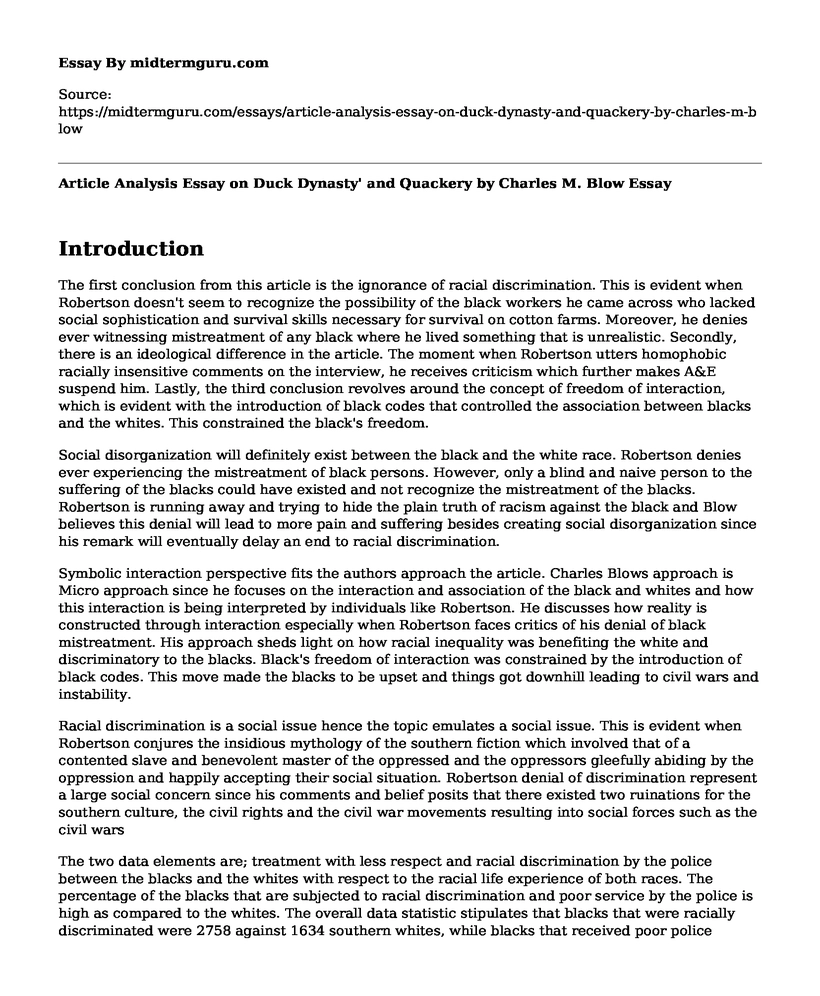Introduction
The first conclusion from this article is the ignorance of racial discrimination. This is evident when Robertson doesn't seem to recognize the possibility of the black workers he came across who lacked social sophistication and survival skills necessary for survival on cotton farms. Moreover, he denies ever witnessing mistreatment of any black where he lived something that is unrealistic. Secondly, there is an ideological difference in the article. The moment when Robertson utters homophobic racially insensitive comments on the interview, he receives criticism which further makes A&E suspend him. Lastly, the third conclusion revolves around the concept of freedom of interaction, which is evident with the introduction of black codes that controlled the association between blacks and the whites. This constrained the black's freedom.
Social disorganization will definitely exist between the black and the white race. Robertson denies ever experiencing the mistreatment of black persons. However, only a blind and naive person to the suffering of the blacks could have existed and not recognize the mistreatment of the blacks. Robertson is running away and trying to hide the plain truth of racism against the black and Blow believes this denial will lead to more pain and suffering besides creating social disorganization since his remark will eventually delay an end to racial discrimination.
Symbolic interaction perspective fits the authors approach the article. Charles Blows approach is Micro approach since he focuses on the interaction and association of the black and whites and how this interaction is being interpreted by individuals like Robertson. He discusses how reality is constructed through interaction especially when Robertson faces critics of his denial of black mistreatment. His approach sheds light on how racial inequality was benefiting the white and discriminatory to the blacks. Black's freedom of interaction was constrained by the introduction of black codes. This move made the blacks to be upset and things got downhill leading to civil wars and instability.
Racial discrimination is a social issue hence the topic emulates a social issue. This is evident when Robertson conjures the insidious mythology of the southern fiction which involved that of a contented slave and benevolent master of the oppressed and the oppressors gleefully abiding by the oppression and happily accepting their social situation. Robertson denial of discrimination represent a large social concern since his comments and belief posits that there existed two ruinations for the southern culture, the civil rights and the civil war movements resulting into social forces such as the civil wars
The two data elements are; treatment with less respect and racial discrimination by the police between the blacks and the whites with respect to the racial life experience of both races. The percentage of the blacks that are subjected to racial discrimination and poor service by the police is high as compared to the whites. The overall data statistic stipulates that blacks that were racially discriminated were 2758 against 1634 southern whites, while blacks that received poor police service were 2350 and the southern whites are 1192. In summary, the blacks are the victims of discrimination and poor service delivery from the police.
First, global strategies should be developed that addresses institutional and individual cases of discrimination and further research to be initiated on racial discrimination globally. Secondly, new and improved international laws that entail severe penalties on those found on the fault side should be enacted. The policies should seek to influence individual behaviors and perception to influence others but not limited efforts of increasing awareness and knowledge. Lastly, relevant programs in schools which will ensure continued set of learning, for instance, courses that focus on racial ethnical differences should be integrated in the syllabus so that the issue can be addressed at early stages
Work Cited
'Duck Dynasty' and Quackery by Charles M Blow, New York Times December 20, 2013
Cite this page
Article Analysis Essay on Duck Dynasty' and Quackery by Charles M. Blow. (2022, Aug 31). Retrieved from https://midtermguru.com/essays/article-analysis-essay-on-duck-dynasty-and-quackery-by-charles-m-blow
If you are the original author of this essay and no longer wish to have it published on the midtermguru.com website, please click below to request its removal:
- Discrimination in the US: A Historical Persistence Since Founding - Essay Sample
- Racial Conflict in Texas: A Turbulent History of Exclusion and Discrimination - Research Paper
- Frida Kahlo: Iconic Embrace of Female Sexuality - Essay Sample
- Paper Example on Rethinking Race, Class, Language, and Gender
- Annotated Bibliography on Racism and Discrimination
- Trauma: A Distressing Mental Health Phenomenon - Essay Sample
- Critical Essay on Clothes by Chitra Banerjee Divakaruni







